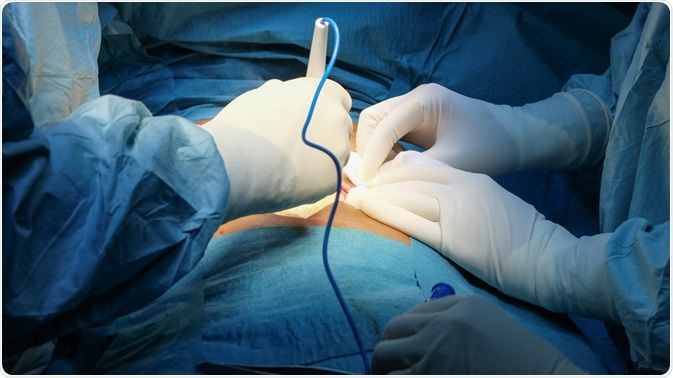Symptoms and Causes of Abdominal Adhesions
An intrinsic property of adhesions is that they are painless and the pain that occurs in connection with adhesions tends to be due to secondary complications. Adhesions, which are bands of scar tissue connecting two parts of tissue that would otherwise not be connected together, develop in response to injury.
 Abdominal Adhesions” />Image Credit: Casa nayafana / Shutterstock.com
Abdominal Adhesions” />Image Credit: Casa nayafana / Shutterstock.com
This injury may be due to infection, trauma, surgery, or radiation. Adhesions are most frequently found in the pelvis, gastrointestinal tract. and the heart. However, they may occur anywhere else in the body that underwent damage of some sort and requires repair.
Clinical presentation of abdominal adhesions
Under normal circumstances, the passage of food, fluid, stool, and gases through the intestines happens freely. In the presence of adhesions, this free passage is disturbed due to the tethering of intestinal loops to each other, other abnormal organs and/ or the abdominal wall.
This obstruction results in symptoms such as abdominal distention and colicky pain that is often worsened with food intake. Furthermore, there is a reduction in stool and/ or flatulence and constitutional symptoms such as nausea and vomiting may occur.
Typical adhesions may show no clinical signs and as a result tend to go unnoticed and undiagnosed. Hepatic adhesions typically cause pain when the patient inhales and exhales deeply, while lesions of the intestinal loops tend to cause more pain with exercise or stretching.
Symptoms that require seeking immediate medical attention include the inability to pass intestinal gas or have a bowel movement, progressive distention of the abdomen accompanied by loud bowel sounds, and severe cramping or abdominal pain.
Pathophysiology of abdominal adhesions
In the natural process of healing, fibrin is deposited onto the tissue that is damaged and it behaves like a glue to seal off the injury. Additionally, the fibrin builds a naïve adhesion onto which the mature one builds to connect adjacent tissues to each other.
Fibrin deposition may be physiologically controlled by enzymes that limit its rate of production and/or dissolve it. However, in the case of scar tissue, this process is incomplete and an adhesion is the end result when repair cells such as fibroblasts and macrophages produce substances like collagen to create a permanent structure. This structure may grow over time and become tighter.
The most frequent cause of abdominal adhesions is surgery. The events during surgery that lead to adhesion formation include incisional procedures, dehydration of abdominal tissues and organs, foreign body contact like gloves with internal tissues, and stale blood not removed during / after the surgery. Certain organs and structures within the abdomen, like the omentum, are more susceptible to developing adhesions.
Nearly all post-operative adhesions, as indicated in one study, are found in the omentum. Furthermore, spontaneous adhesions, although rare (less than 10% of all adhesions), tend to also occur mostly in the omentum.
Non-surgical causes of abdominal adhesions arise from complications such as a ruptured appendix, radiation therapy, and abdominal as well as gynecological infections.
Sources
- radpacs.weber.edu/…/…20path%[email protected]_20120206_103818.pdf
- www.niddk.nih.gov/…/facts.aspx
- https://www.ncbi.nlm.nih.gov/pmc/articles/PMC2992017/
Further Reading
- All Abdominal Adhesion Content
- What are Abdominal Adhesions?
- Diagnosis and Treatment of Abdominal Adhesions
Last Updated: Jan 13, 2021

Written by
Dr. Damien Jonas Wilson
Dr. Damien Jonas Wilson is a medical doctor from St. Martin in the Carribean. He was awarded his Medical Degree (MD) from the University of Zagreb Teaching Hospital. His training in general medicine and surgery compliments his degree in biomolecular engineering (BASc.Eng.) from Utrecht, the Netherlands. During this degree, he completed a dissertation in the field of oncology at the Harvard Medical School/ Massachusetts General Hospital. Dr. Wilson currently works in the UK as a medical practitioner.
Source: Read Full Article
